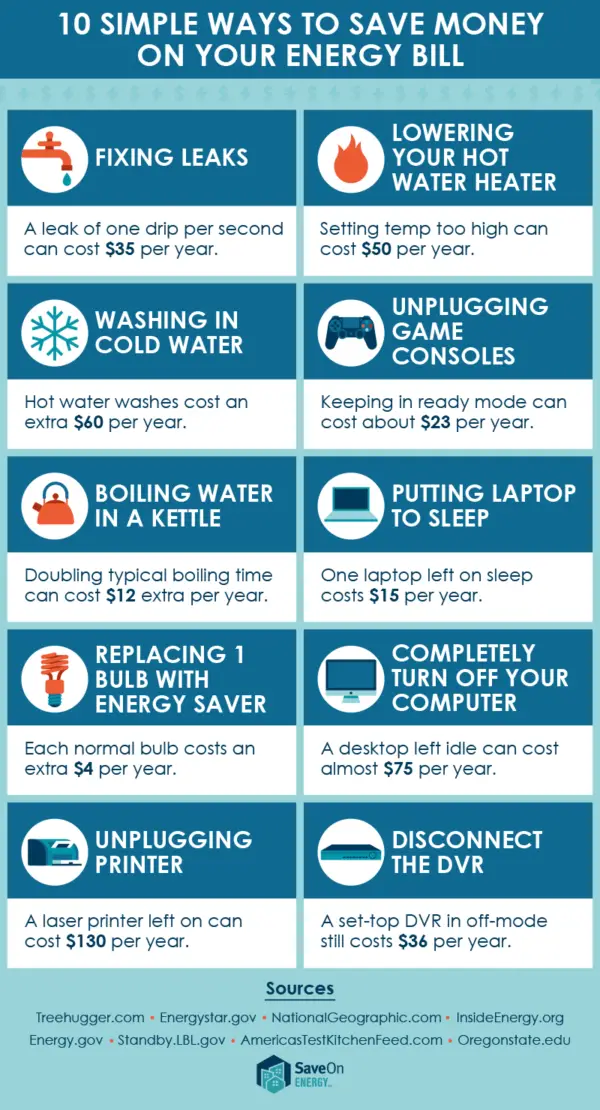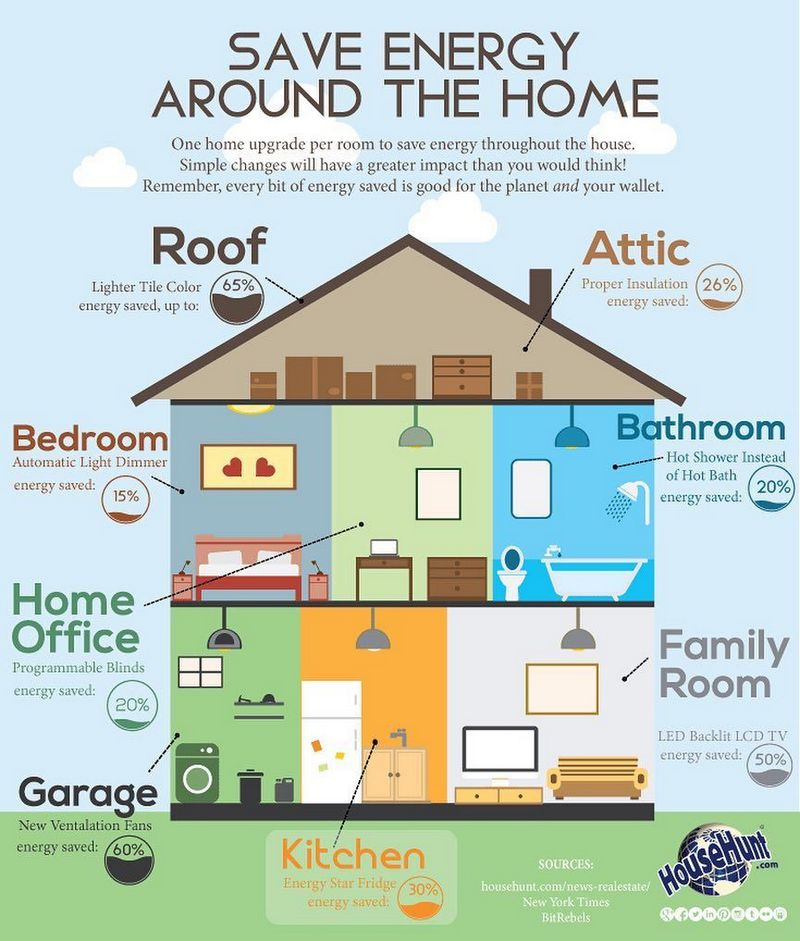
Energy Saving Tips for Around the Home
Are you tired of high energy bills? Want to find simple ways to save money and reduce your energy consumption? Look no further! In this article, we will provide you with some practical and easy-to-implement tips to make your home more energy-efficient.
One of the easiest ways to save energy is by properly insulating your home. By adding insulation to your walls, attic, and floors, you can reduce heat loss in the winter and keep your home cooler in the summer, ultimately reducing the amount of energy needed to maintain a comfortable temperature.
Another area where you can make a big difference is your windows. Poorly sealed windows can let air escape and allow drafts to enter your home, which can significantly impact your energy bills. Consider applying weatherstripping or caulking around your windows to prevent air leakage and improve energy efficiency.
Did you know that adjusting your thermostat by just a few degrees can have a significant impact on your energy consumption? By lowering your thermostat in the winter and raising it in the summer, you can save energy and reduce your utility bills. Don’t forget to install a programmable thermostat to automatically adjust the temperature when you’re away from home or sleeping.
Finally, let’s talk about lighting. Switching to LED bulbs can save you a significant amount of money on your energy bills. LED bulbs use less energy and last longer than traditional incandescent bulbs, making them a great investment for your home. Remember to turn off lights when you’re not using them and take advantage of natural light whenever possible to further reduce your energy consumption.
By implementing these simple tips, you can make a big difference in your energy usage and lower your utility bills. Start saving today and enjoy a more energy-efficient home!
Top Energy Saving Tips
Reducing energy consumption in your home is not only good for the environment, but it can also help you save money on your utility bills. Here are some energy saving tips to consider:
- Lighting: Replace traditional light bulbs with energy-efficient LED or CFL bulbs. These bulbs use less energy and last longer, saving you money in the long run.
- Insulation: Properly insulate your home to prevent heat or cool air from escaping. This will reduce the amount of energy needed to heat or cool your home.
- Windows: Install energy-efficient windows or add window treatments such as blinds or curtains to keep heat out in the summer and retain warmth in the winter.
- Appliances: Choose energy-efficient appliances when possible. Look for the Energy Star label, which indicates that the appliance meets certain energy efficiency standards.
- Saving: Turn off lights, electronics, and appliances when they are not in use. Unplug devices that are not in use to avoid standby power consumption.
- Thermostat: Set your thermostat to a lower temperature in the winter and a higher temperature in the summer. Adjusting your thermostat by just a few degrees can result in significant energy savings.
By following these energy saving tips, you can reduce your energy consumption and lower your utility bills. Small changes can make a big difference in both your wallet and the environment.
Reduce Your Utility Bills with These Simple Habits
Reducing your utility bills doesn’t have to be complicated. By adopting a few simple habits around your home, you can make a big difference in your energy consumption and save money in the process. Here are some easy tips to get you started:
1. Unplug Appliances
Many appliances continue to use energy even when they’re turned off. By unplugging devices such as televisions, chargers, and coffee makers when you’re not using them, you can save on your electricity bill. Consider using power strips to easily turn off multiple devices at once.
2. Use Energy-Saving Windows
Windows can be a major source of heat loss or gain in your home. Installing energy-saving windows that provide proper insulation can help regulate the temperature inside, reducing the need for heating or cooling systems. Look for windows with low-emissivity coatings and double or triple glazing for maximum energy efficiency.
3. Improve Insulation
Poor insulation can lead to significant energy loss. Insulating your home properly can help maintain a comfortable temperature without overworking your heating or cooling systems. Seal any cracks or gaps in windows, doors, and walls, and consider adding insulation to your attic and basement to further improve energy efficiency.
4. Adjust Your Thermostat
Lowering your thermostat by just a few degrees in winter or raising it in summer can result in significant energy savings. Consider investing in a programmable thermostat that allows you to schedule temperature changes based on when you’re home or away.
5. Switch to Energy-Efficient Lighting
Traditional incandescent light bulbs consume a lot of energy and have a short lifespan. Switching to energy-efficient LED or CFL bulbs can significantly reduce your lighting expenses. These bulbs use less energy, last longer, and emit less heat, making them an excellent choice for energy-conscious homeowners.
By implementing these simple habits, you can reduce your utility bills and make your home more energy-efficient. Start with one or two changes, and gradually incorporate more as you see the savings add up. Remember, even small steps can lead to significant energy savings over time.
Insulate Your Home Properly
Proper insulation is a key energy-saving measure for your home. It helps to create an efficient thermal barrier that prevents the transfer of heat between the inside and outside of your home. Good insulation can keep your home cool in the summer and warm in the winter, reducing the need for heating and cooling systems and saving you money on your energy bills.
Here are some tips for insulating your home:
- Check your windows: Windows are one of the main sources of heat loss in a home. Inspect your windows for any cracks or gaps, and consider adding weatherstripping or caulk to seal them properly.
- Insulate your attic: Heat rises, so insulating your attic is crucial for preventing heat loss. Consider adding insulation in your attic to keep the warm air inside during the winter months.
- Seal air leaks: Look for any gaps or cracks in your home’s exterior walls, floors, and ceilings. Use caulk or weatherstripping to seal these air leaks and prevent drafts.
- Insulate your walls: Insulating your walls can also help to reduce heat loss. Consider adding insulation to your exterior walls, especially if you live in a colder climate.
- Use insulation blankets: Insulation blankets are an effective way to insulate hot water heaters and other appliances that generate heat. They help to prevent heat loss, reducing the need for the appliances to work harder and consume more energy.
By properly insulating your home, you can improve its energy efficiency and reduce your utility bills. Taking the time to insulate your windows, attic, walls, and appliances will help to keep your home comfortable and save you money in the long run.
Upgrade to Energy-Efficient Appliances
One of the most effective ways to save energy in your home is by upgrading to energy-efficient appliances. These appliances are designed to use less energy without sacrificing performance, helping you reduce your utility bills and lower your carbon footprint. Here are some tips to help you choose and use energy-efficient appliances:
- Look for the ENERGY STAR label: When shopping for appliances such as refrigerators, dishwashers, and washing machines, look for the ENERGY STAR label. This label indicates that the appliance meets strict energy efficiency guidelines set by the Environmental Protection Agency and the Department of Energy.
- Consider the energy rating: Pay attention to the Energy Guide label on appliances, which provides information on estimated yearly energy consumption and operating costs. Choose appliances with a higher energy rating for maximum energy savings.
- Opt for appliances with smart features: Many modern appliances come with smart features that allow you to control and monitor their energy usage. For example, smart thermostats can learn your schedule and adjust the temperature accordingly, while smart power strips can automatically turn off electronics when they’re not in use.
- Choose the right size: When buying appliances such as air conditioners or refrigerators, choose the right size for your needs. Oversized appliances not only waste energy, but they also take up unnecessary space in your home.
- Proper maintenance: Regularly clean and maintain your appliances to ensure optimal energy efficiency. For example, clean the lint filter in your dryer to improve airflow and reduce drying time.
- Consider energy-efficient cooking appliances: Upgrade your cooking appliances to energy-efficient options such as induction cooktops and convection ovens. These appliances are not only more efficient, but they also offer better precision and faster cooking times.
By upgrading to energy-efficient appliances, you can enjoy significant energy savings in your home. Not only will you reduce your utility bills, but you’ll also contribute to a more sustainable future by conserving precious energy resources.
Adjust Your Thermostat
One of the easiest ways to save energy and reduce your utility bills is to adjust your thermostat. By properly managing the temperature in your home, you can significantly decrease your energy consumption and improve the efficiency of your heating and cooling systems.
1. Insulation: Before adjusting your thermostat, make sure your home is properly insulated. Insulation helps to prevent heat transfer through the walls, floors, and ceilings. It keeps your home warmer in the winter and cooler in the summer, reducing the need for excessive heating or cooling.
2. Programmable Thermostat: Consider installing a programmable thermostat if you don’t have one already. This allows you to set specific temperatures for different times of the day or week. For example, you can program the thermostat to lower the temperature when you’re away from home or asleep, and raise it when you’re back or awake.
3. Windows and Doors: Check for any drafty areas around windows and doors. Use weatherstripping or caulk to seal any gaps or cracks to prevent cold air from entering or warm air from escaping. This will help your thermostat work more efficiently and maintain a consistent temperature within your home.
4. Energy-Efficient Appliances: Use energy-efficient appliances and electronics that produce less heat. This reduces the amount of heat your thermostat needs to compensate for, resulting in energy savings.
5. Lighting: Switch to energy-efficient lighting options such as LED bulbs. LED bulbs are more efficient and last longer than traditional incandescent bulbs. They produce less heat and consume less energy, helping to reduce the load on your thermostat.
By adjusting your thermostat and implementing these energy-saving tips, you can make a significant impact on your utility bills and contribute to a more sustainable environment.
Make the Most of Natural Light
One of the simplest and most effective ways to save energy and reduce your utility bills at home is to take advantage of natural light. By maximizing the use of natural light, you can minimize the need for artificial lighting and reduce your energy consumption.
Here are some tips on how to make the most of natural light in your home:
- Keep your windows clean and free from obstructions: Dirty windows can block out natural light and reduce the amount of sunlight that enters your home. Regularly clean your windows to ensure maximum light penetration.
- Consider the position of your windows: Take note of the direction your windows face and the amount of sunlight they receive throughout the day. This will help you determine which rooms receive the most natural light and how to arrange your furniture accordingly.
- Utilize light-colored or reflective surfaces: Light-colored walls, ceilings, and floors can help to reflect and distribute natural light throughout your home. Consider painting your walls in light shades or using reflective materials to maximize the impact of sunlight.
- Use light-colored window treatments: Opt for light-colored curtains, blinds, or shades that allow natural light to filter through while still providing privacy and insulation. Heavy, dark-colored window treatments can block out sunlight and reduce the amount of natural light in your home.
- Install skylights or light tubes: If possible, consider installing skylights or light tubes in areas that lack natural light, such as hallways or bathrooms. These can bring in additional sunlight and brighten up otherwise dark spaces.
- Make use of daylighting fixtures: Daylighting fixtures are specially designed to optimize the use of natural light in your home. They can be installed in areas with limited access to natural light and help to supplement your overall lighting needs.
By following these tips and making the most of natural light, you can reduce your reliance on artificial lighting, lower your energy consumption, and enjoy the benefits of a well-lit and energy-efficient home.
Install Energy-Saving Light Bulbs
One of the easiest and most effective ways to save energy and reduce your utility bills is to install energy-saving light bulbs in your home. Traditional incandescent light bulbs waste a lot of energy by emitting heat, while energy-saving bulbs are designed to produce the same amount of light using less energy.
There are two main types of energy-saving bulbs: compact fluorescent lamps (CFLs) and light-emitting diodes (LEDs). Both options offer significant energy savings compared to traditional incandescent bulbs.
Compact Fluorescent Lamps (CFLs)
CFLs are a popular choice for energy-efficient lighting. They are more energy-efficient than incandescent bulbs and last up to 10 times longer. CFLs use about 75% less energy and can save you around $30 in electricity costs over the bulb’s lifetime.
It’s important to note that CFLs contain a small amount of mercury, so it’s essential to handle and dispose of them properly. Many communities have recycling programs or drop-off locations for CFL bulbs.
Light-Emitting Diodes (LEDs)
LEDs are another great option for energy-saving lighting. They are even more energy-efficient than CFLs and last even longer. LEDs use up to 80% less energy than incandescent bulbs and can last up to 25 times longer. While LEDs are initially more expensive, they pay for themselves over time through energy savings.
LEDs come in a variety of colors and can be dimmed, making them versatile for different lighting needs in your home. They are also more durable than traditional bulbs, as they are resistant to shocks, vibrations, and extreme temperatures.
Tips for Installing Energy-Saving Light Bulbs
- Replace your most frequently used bulbs first, such as those in the living room and kitchen.
- Consider the brightness and color temperature of the bulb when making your choice.
- If you want to dim the lights, make sure the bulb is dimmable.
- Keep in mind that CFLs need a short warm-up time to reach their full brightness.
- Switch to LEDs for outdoor lighting, as they are more resistant to weather conditions.
By installing energy-saving light bulbs throughout your home, you can make a significant impact on your energy consumption and reduce your utility bills. These simple swaps can help you save money and contribute to a more sustainable future.
Unplug Electronics When Not in Use

In today’s modern society, it’s hard to imagine a home without appliances. We rely on them for cooking, cleaning, entertainment, and more. However, many of these electronic devices continue to use energy even when they are turned off or in standby mode. This is known as “phantom energy” or “vampire power.”
To prevent unnecessary energy consumption and reduce your utility bills, it is important to unplug electronics when they are not in use. Here are some tips to help you save energy around your home:
- Unplug chargers: When you’re done charging your phone, laptop, or other devices, unplug the charger from the wall. Leaving it plugged in still consumes energy, even if there is no device connected.
- Turn off power strips: Many electronics are plugged into power strips to make it easier to turn multiple devices on and off at once. However, even when the power strips are turned off, they can still draw power. Make it a habit to turn off the power strip when you’re not using the appliances connected to it.
- Use timers or smart plugs: If you have devices that need to be plugged in all the time, like a modem or a router, consider using timers or smart plugs. These devices can be programmed to turn on and off at specific times, so you can avoid wasting energy when you’re not using them.
- Create a charging station: Instead of leaving your devices plugged in all over the house, create a designated charging station where you can plug them in when needed. This will make it easier to unplug them when they are fully charged or not in use.
- Unplug appliances when on vacation: If you’re going on a vacation or leaving your home for an extended period, unplug all non-essential appliances. This will help you save a significant amount of energy while you’re away.
By unplugging electronics when they are not in use, you can significantly reduce your energy consumption and lower your utility bills. It’s a simple and easy way to make your home more energy efficient. Remember, every little step counts when it comes to saving energy and protecting the environment.
Use Power Strips
One of the easiest ways to save energy and reduce your utility bills is by using power strips. Power strips are not only convenient for managing multiple electronic devices, but they can also help you save energy.
Here are some tips on how to use power strips effectively:
- Turn off standby mode: Many electronic devices consume energy even when they are turned off or in standby mode. By plugging them into a power strip and turning off the strip when not in use, you can eliminate this energy waste.
- Unplug unused devices: Even when electronic devices are turned off, they may still draw power if they are left plugged in. By using a power strip, you can easily unplug multiple devices at once, such as chargers, gaming consoles, or printers, when they are not being used.
- Use timers: If you have devices that need to be on at specific times, such as lamps or holiday decorations, consider using a power strip with a built-in timer. This way, you can schedule the devices to turn on and off automatically, reducing energy waste.
Power strips are especially useful for managing the energy consumption of devices that are often forgotten, such as televisions, speakers, or kitchen appliances. By turning off the power strip when these devices are not in use, you can significantly reduce standby energy consumption.
It’s important to note that not all power strips are created equal. Look for power strips with built-in surge protection to protect your devices from electrical spikes. Additionally, consider investing in advanced power strips that can detect when devices are in standby mode and automatically cut off power to them, further increasing energy savings.
By using power strips effectively, you can take control of your energy usage and make a positive impact on the environment while also saving money on your utility bills.
Eliminate Drafts
Drafts can be a major source of energy loss in your home, causing your heating or cooling system to work harder and use more energy. By taking steps to eliminate drafts, you can save energy and reduce your utility bills.
Here are some tips to help you eliminate drafts:
- Seal windows and doors: Check for any gaps or cracks around your windows and doors. Use weatherstripping or caulk to seal these areas and prevent drafts from entering your home.
- Install window insulation film: Window insulation film is a thin plastic sheet that can be applied to the inside of your windows. It helps to trap heat inside your home and prevent drafts. It is easy to install, affordable, and can make a noticeable difference in energy savings.
- Use draft stoppers: Draft stoppers, also known as door snakes or draft excluders, are long fabric tubes filled with insulation material. They can be placed along the bottom of doors to prevent drafts from coming in.
- Insulate your attic and walls: Proper insulation in your home can help prevent drafts and keep your home more comfortable year-round. Make sure your attic and walls are properly insulated to reduce energy loss.
In addition to eliminating drafts, here are some other energy-saving tips for your home:
- Use a programmable thermostat to regulate the temperature in your home. Set it to lower or raise the temperature when you’re not at home or asleep.
- Replace old appliances with energy-efficient models. Energy-efficient appliances use less electricity and can help reduce your energy usage.
- Turn off lights, electronics, and appliances when they’re not in use. Even in standby mode, these devices can consume a significant amount of energy.
- Take shorter showers and use low-flow showerheads to reduce water and energy usage.
By implementing these energy-saving tips and eliminating drafts in your home, you can significantly reduce your utility bills and contribute to a more sustainable future.
Use Ceiling Fans Properly
Using ceiling fans properly can help you save energy and reduce your utility bills. Here are some tips to make the most out of your ceiling fans:
- Adjust the fan direction: In summer, set your ceiling fan to rotate counterclockwise. This creates a cool breeze that can make the room feel up to 4 degrees cooler without actually lowering the temperature. In winter, set the fan to rotate clockwise to push warm air down from the ceiling.
- Turn off when not in use: Remember to turn off your ceiling fans when you leave the room. Fans cool people, not rooms, so there’s no need to keep them running if no one is benefiting from the airflow.
- Use alongside air conditioning: Ceiling fans can complement your air conditioning system by circulating the cool air throughout the room. This allows you to set your thermostat a few degrees higher, which can result in significant energy savings.
- Optimize lighting: Consider replacing your traditional incandescent light bulbs with energy-efficient LED bulbs. LED bulbs produce less heat, reducing the strain on your cooling system and saving energy.
- Improve home insulation: Proper insulation in your home can prevent the loss of cooled or heated air, making your ceiling fans more effective. Insulate your windows and doors, seal any air leaks, and ensure your home is properly insulated.
- Adjust your thermostat: By using ceiling fans in conjunction with your thermostat, you can adjust the temperature settings and potentially save on energy costs. During hot weather, you can raise the thermostat a few degrees and rely on the fan to keep you comfortable.
By using your ceiling fans properly, you can maximize their energy-saving potential and enjoy a more comfortable home environment.
Lower Your Water Heater Temperature
One of the easiest and most effective ways to save energy and reduce your utility bills is by lowering the temperature of your water heater. Many water heaters are set at a default temperature of 140°F (60°C), but you can typically lower this to 120°F (49°C) without sacrificing your comfort.
Lowering your water heater temperature has several benefits. First, it reduces the amount of energy needed to heat the water, which can significantly lower your energy usage and save on your monthly bills. Second, it can help prevent scalding accidents, especially if you have children or elderly people living in your home. Third, it can extend the life of your water heater by reducing the wear and tear on its components.
To lower your water heater temperature, follow these simple steps:
- Locate the temperature dial: The temperature dial is usually located on the front or side of the water heater. It may be labeled as “Temperature” or “Thermostat.”
- Turn off the power: Before making any adjustments, turn off the power to the water heater. This can usually be done by flipping the corresponding breaker in your electrical panel.
- Adjust the temperature: Use a flathead screwdriver or another suitable tool to adjust the temperature dial. Turn it counterclockwise to lower the temperature to your desired setting, usually around 120°F (49°C).
- Wait and check: After making the adjustment, wait a few hours for the water to heat up and check the temperature at a faucet. Adjust the dial if necessary to achieve your desired temperature.
- Note: If you have a gas water heater, it’s recommended to consult the manufacturer’s instructions or hire a professional to adjust the temperature.
In addition to lowering your water heater temperature, there are other energy-saving tips you can implement in your home. These include proper insulation, using energy-efficient appliances, switching to LED lighting, and sealing windows and doors to prevent drafts. By incorporating these tips into your daily routine, you can make a significant impact on reducing your energy consumption and lowering your utility bills.
Plant Trees for Natural Shade
One of the easiest ways to reduce your home’s energy consumption is by planting trees for natural shade. By strategically placing trees around your home, you can block direct sunlight from entering your windows and thereby reduce the need for artificial lighting and cooling.
Here are some tips for planting trees for natural shade:
- Choose the right type of tree: Look for trees that have a wide and dense canopy, such as maple or oak trees. These types of trees provide better shade and can help to cool down your home.
- Plant trees strategically: Consider the position of the sun and prevailing winds when choosing where to plant your trees. Plant them on the south and west sides of your home to block the most intense sunlight.
- Provide shade for windows: Plant trees near windows to block direct sunlight. This will reduce the heat gain inside your home, allowing you to rely less on air conditioning.
- Insulate your home: In addition to providing shade, trees also offer insulation benefits. They act as a barrier against heat transfer and help to keep your home cooler in the summer and warmer in the winter.
By planting trees for natural shade, you can significantly reduce your home’s energy consumption and lower your utility bills. Plus, it adds beauty to your property and contributes to a healthier environment.
Use Energy-Saving Window Coverings
One of the easiest and most effective ways to save energy in your home is by using energy-saving window coverings. Windows are a major source of heat gain and loss, especially during hot and cold seasons. By choosing the right window coverings, you can significantly reduce the amount of energy needed to heat or cool your home.
Here are some tips on how to choose and use energy-saving window coverings:
- Insulated Curtains: Invest in insulated curtains that are designed to keep the heat out during summer and keep it in during winter. These curtains have a layer of insulating material that helps to reduce heat transfer through the windows.
- Shades: Install shades that are made from light-colored fabrics to reflect the sun’s rays. This will help to keep your home cooler during summer, reducing the need for air conditioning.
- Blinds: Use blinds that have adjustable slats, so you can control the amount of light and heat that enters your home. Close the blinds during the hottest parts of the day to reduce heat gain.
- Window Film: Apply window film to your windows to block out a significant amount of heat from the sun. Window film is available in different levels of light and heat transmittance, allowing you to choose the one that suits your needs.
In addition to using energy-saving window coverings, it’s also important to properly seal your windows to prevent air leakage. This can be done by applying weatherstripping or caulking around the window frames.
By taking these simple steps, you can save energy, reduce your utility bills, and create a more comfortable living environment in your home.
Clean and Maintain Your Appliances
Properly cleaning and maintaining your appliances can greatly contribute to energy savings in your home. By ensuring that your appliances are functioning efficiently, you can reduce energy waste and lower your utility bills. Here are some tips for cleaning and maintaining common household appliances:
- Refrigerator: Regularly clean the coils on the back of your refrigerator to remove dust and debris. This will help the fridge run more efficiently and reduce energy consumption. Additionally, defrosting your freezer regularly will improve its efficiency.
- Dishwasher: Clean the filter of your dishwasher regularly to prevent clogs and ensure proper water flow. Use the dishwasher’s energy-saving mode and only run it when you have a full load of dishes.
- Washing machine: Clean the lint filter on your washing machine to improve energy efficiency and prevent clogs. Use cold water whenever possible and consider using a high-efficiency detergent to save energy.
- Dryer: Remove lint from the dryer filter after each use to improve airflow and reduce drying time. Ensure that the dryer vent is clear of obstructions to improve efficiency.
- Oven: Regularly clean the oven by wiping up spills and removing excess grease. Keeping the oven clean helps it heat more efficiently and reduces cooking times.
In addition to cleaning, proper maintenance of your appliances is important for energy savings:
- Regular servicing: Schedule regular maintenance for your appliances, such as annual check-ups for your HVAC system, to ensure they are running at peak efficiency.
- Seal leaks: Inspect the seals around your appliances, such as the refrigerator door and oven door, and replace any damaged or worn-out seals. This will help maintain the temperature inside the appliances and reduce energy waste.
- Upgrade when necessary: If your appliances are old and inefficient, consider upgrading to Energy Star certified models. These appliances are designed to be energy-efficient and can help you save on your utility bills.
By regularly cleaning and maintaining your appliances, you can ensure they are running efficiently and save on energy costs in your home.
Educate Your Family on Energy Saving
One of the most effective ways to reduce your energy usage and save money on your utility bills is to educate your family on energy-saving habits. By making small changes to their daily routines and habits, everyone in your household can contribute to a more energy-efficient home.
Here are some tips to help educate your family on energy saving:
- Unplug appliances when not in use: Encourage your family members to unplug electronic devices and appliances when they are not being used. Many appliances, such as televisions and game consoles, consume energy even when they are on standby mode, so it’s important to unplug them to save energy.
- Switch to LED lighting: Replace traditional incandescent light bulbs with energy-efficient LED bulbs. LED bulbs use up to 80% less energy and last much longer than incandescent bulbs, resulting in significant savings on your energy bills.
- Set the thermostat wisely: Teach your family members to set the thermostat at an energy-saving temperature. During the winter, lowering the thermostat by just a few degrees can save a significant amount of energy. In the summer, raising the thermostat and using fans can help reduce the load on your air conditioner and save energy.
- Seal windows and doors: Make sure your family understands the importance of sealing windows and doors properly. Drafts can waste a lot of energy by letting cold air in during the winter and hot air in during the summer. Use weatherstripping or caulk to seal any gaps or cracks around windows and doors.
By discussing and implementing these energy-saving tips at home, you can make a big difference in reducing your household’s energy consumption and lowering your utility bills. Saving energy not only helps your wallet but also reduces your environmental impact.
Question-answer:
What are some easy ways to reduce utility bills?
There are several easy ways to reduce utility bills in your home. Some of these include turning off lights when they are not in use, unplugging electronics when they are not being used, using energy-efficient appliances, using natural light as much as possible, and adjusting your thermostat to a lower temperature in the winter and a higher temperature in the summer.
How can I save energy when using appliances?
To save energy when using appliances, you can make sure to only run them when you have a full load, use the energy-saving mode if available, and clean or replace filters regularly. Additionally, you can use smart power strips to eliminate standby power and unplug appliances when they are not in use. Lastly, using energy-efficient appliances can also help reduce energy usage.
What are some ways to conserve water in the home?
There are several ways to conserve water in the home. Some of these include taking shorter showers, fixing any leaks or drips, installing low-flow showerheads and faucets, using a dishwasher and washing machine with full loads, and watering your plants in the early morning or late evening to prevent evaporation. Additionally, you can consider collecting rainwater for outdoor use and using a broom instead of a hose to clean outdoor areas.
What are some easy ways to reduce my utility bills?
There are several easy ways to reduce your utility bills. One way is to turn off lights and appliances when you’re not using them. Another way is to unplug electronics and chargers when they’re not in use. You can also adjust your thermostat to save energy and lower your heating and cooling costs. Additionally, using energy-efficient light bulbs and appliances can help reduce your utility bills.








